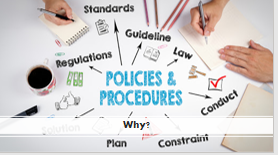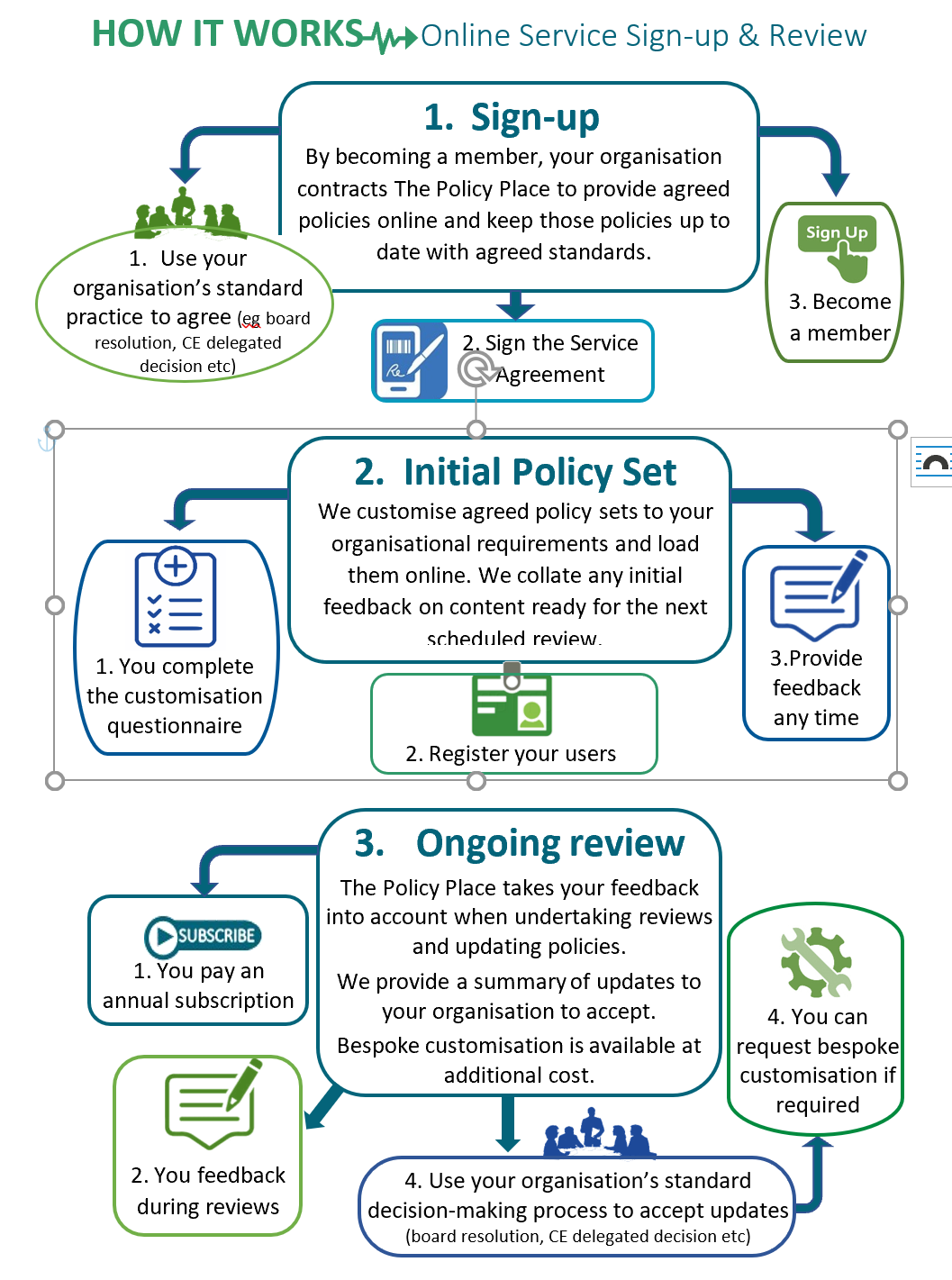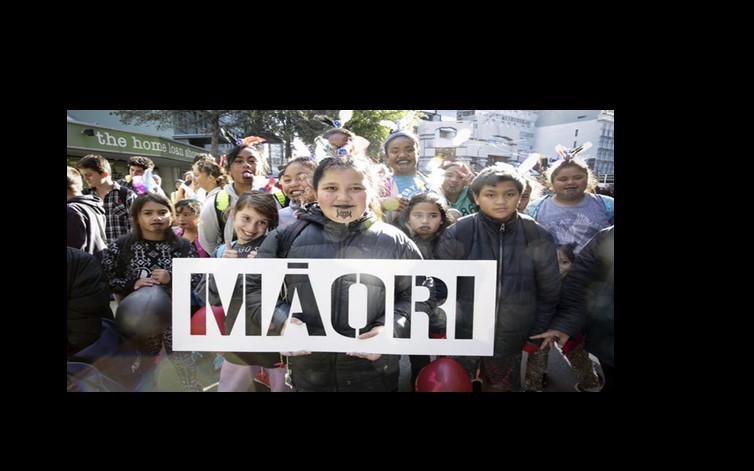Posts Tagged ‘policy review’
Policy and Procedure Templates – generic & customised
Policy and procedure templates can take you from the bottom of the hill straight to the top.
Most organisations need policies and procedures. But getting your policies sorted can feel like an uphill battle that doesn’t ever end. Templates though can, depending on the type you choose, give you the basic structure to get you started through to all the policy content you need.
To help you make the best choice, we’re reviewing a range of different template options – considering their pros and cons. The good news for social, health, education and housing agencies is that you can access all options through The Policy Place.

Starter Policy and Procedure Templates
If you’re wanting a policy template that gives you a structure to start with, there are a few options around that basically offer advice about policy writing. They typically give you a policy structure along the lines of headings like Purpose; Policy; Procedures; Responsibilities; Related Documents and Policies.
The Workplace Policy Builder is a good example.
Having a structure can help get you started and is a good option if you’re into the DIY and freebies. However, you’ve still got all the hard work of policy creation to do.🤔 Not only that. You also have to keep the content reviewed and updated for currency with law, regulations, and other requirements.
Area-specific Policies
There are lots of policy templates on the market aimed at particular areas like Human Resources and Health and Safety. Sometimes the products come with additional advisory services like HR advice and support. They are a good option if you want access to particular knowledge and expertise.
BUT…
These products can be expensive.
AND…
They can be challenging to implement because they are not typically focused on your particular organisational context. Although they may incorporate some branding and sometimes, an introduction from the CE, they usually apply generally, which comes through in the content.
The Policy Place online policy service overcomes these problems:
![]()
- We are not wholly generic. We provide core policy content but specifically for different contexts of social services, health, disability, housing and education and to a limited extent for an organisation itself.
- We are cost-effective because we address common policy needs of organisations associated with law, regulations and compliance standards and want to be accessible to cash-strapped non-profits and start-ups.
- We keep core policy content reviewed and updated for members.
Customised Policy and Procedure Templates
Customised policy products are harder to come by. That’s because they’re usually done by consultants. They can be great because they are built around the organisation’s particular needs and incorporate a lot of operational detail.
BUT…..
Customised policies are usually very expensive. This reflects a heavy investment of time by consultants with specialist knowledge.
AND
Customised policies are a one-off product. They are not subject to regular review and updating, which is required for compliance with standards that apply in areas like Health and Disability, Social Services, Training and Housing.
You can have it all
The Policy Place offers you the chance to customise your policies while reaping the benefits of regular reviews and updates of core policy content. Customisation is optional and done by you as the client.
- The system works easily:
- You sign up for the Essentials Package, which the Policy Place puts together for you based on the information you provide and your compliance needs.
- You decide on how you might want to customise – add paragraphs or pages, edit core policy text or grab it all.
- You decide who you want to authorise to customise your policies and authorise them on the system.
Any problems? Contact the Policy Place who wll help.
Are you missing out? Is good policy what you need?
Are you missing out on the benefits of having good up-to-date policies and procedures? In this post, we look at the value of good policy and procedures for organisations of all types.
If you want to get more out of your operating expenses and want more time to spend on other things, then read on.
Policies are multi-functional
Organisational policies and procedures are not just about compliance. They are multi-functional:
- They are like a will. They help avoid the chaos and distress of uncertainty about what to do about a situation.
- They double as a how-to guide for staff when faced with new responsibilities, roles and challenges.
- If you’re expanding into new areas or building new collaborations, policies and procedures can be used to reflect agreement on the important stuff like communication, reporting, information-sharing, expenditure and income allocation.
- They help you manage risks, for example of litigation, penalties, health and safety issues and risks to reputation.
Great bang for your buck. Yet, so many organisations and businesses are not reaping these benefits.
Danger
Too often organisations’ policies and procedures sit in old electronic and paper files, pulled out just for audits then put away again.
To state the obvious, this is dangerous! It’s a bit like not maintaining the structure of your house or whare. Eventually, rot can set in and more damage occur.
Unfortunately, we hear of lots of such calamities. Some publicly-aired ones include:
- injuries in childcare centres where there was no policy and procedure to guide action and as a result, errors were made;
- injury to a person being transported by an agency without sufficient safeguards in place;
- abuse perpetrated against children and disabled people in residential settings where processes for reporting concerns were inadequate; and
- a failure to provide adequate medical treatment where there was no policy and procedure on informed consent and client-centred practice.
Time waster
Without good organisational policies, you’re also likely to be wasting a lot of needless time and energy, for example:
- repeatedly telling staff what to do and having them tell you that they don’t know what to do
- dealing with complaints
- solving recurring problems with ad-hoc responses
- doing fix-its on solutions that were made up by staff because they couldn’t access good guidance.
It’s wasted time; time that could be better spent on yourself or whānau or on other organisational priorities.
What’s good organisational policy and procedure?
To help figure out what state your policies and procedures are in, consider the criteria for policies and procedures in the NZS 8134.1: 2008 Health and Disability Services Standards. Standard 2.3 requires policies and procedures to:
- align with current good practice and service delivery
- meet legislative requirements
- be reviewed regularly
- be supported by a document control system to ensure that old versions of policies are not being used.
Guidance for NZS 8134.3.1:2008 recommends additional criteria; that policies and procedures should:
- be written and relevant to the organisation
- be sufficiently flexible to respond to consumer needs
- have a user-friendly format
- contain appropriate technical information
- be accessible to all staff
- be developed and regularly reviewed with relevant service providers
- identify helpful links (ie to other documents)
See here for how the Policy Place online policy and procedure service measures up.
Where to start
The task of reviewing and updating policies and procedures can feel overwhelming. It can be hard to know where to start.
If you’re into the DIY approach, as a first step get updated on legislation changes. Take a look at our post outlining key legislation changes over the last year. At the very least you will need to review and update your policies using the legislation and the standards with which you much comply (ie SASS or HD stds.) Involve staff, research and reflect good practise literature.
Let us handle it
You can let go of the stress and give us the job to do. At the Policy Place we are reviewing and updating organisations’ policies and procedures all the time. You get the benefits of policies and procedures that reflect cross-sector knowledge of good practice and policy and procedure expertise.
We give you policies and procedures fit for the 21st century with our online service. We keep them updated and regularly reviewed so you, your board and staff, have a lot less to worry about and a lot more time and energy for the things you want to do (eg recreation and leisure, other work priorities).
Book your free policy consultation
Email us about your policy and procedure needs.
Online policies and procedures – so easy!
Kia mauriora te reo Māori
Could you achieve 85 per cent of your staff and board valuing te reo Māori? Did you know we have a new Māori language strategy to achieve that as a nation? Already achieved that goal? Consider a language plan to support 85% of your staff and board to speak te reo Māori.
We all have a role in the revitalisation of te reo Māori. We all have much to gain.
This was a key message in the Waitangi Tribunal’s 1986 Report on Te Reo Māori claim and more recently in its Ko Aotearoa Tenei report.
It’s a message that is now reflected in the principles of Te Ture mō Te Reo Māori 2016/ the Māori Language Act 2016. The principles of the Act include that te reo Māori:
- has inherent mana and is enduring
- is the foundation of Māori culture and identity
- enhances the lives of iwi and Māori
- is protected as a taonga under Article 2 of the Treaty
- is important to our national identity.
The Government recently launched its new Māori language strategy under this Act. It reflects these new legislative principles and responds to long-time calls for the language to be protected as a taonga and revitalised.
So what does all of this mean for those of us working outside government? In this post I look at what we can do to support the revitalisation of the reo.
Maihi Karauna
This is the government’s new strategy to revitalise the reo. It replaces the previous Māori language strategy, which was strongly criticised by the Waitangi Tribunal for being deficient and contributing to a decline in the use of te reo Māori (Ko Aotearoa Tenei, pp 165-7).
Maihi Karauna was developed as a partnership between the Crown and iwi and Māori (represented by Te Mātāwai). It provides for:
- Te Mātāwai to focus on homes, communities and the nurturing of tamariki Māori as first language speakers of te reo Māori. Whānau, hapū and iwi are a vital part. See here for Te Mātāwai’s Maihi Māori/ Māori strategy
- the Crown to create and foster societal conditions where te reo Māori is valued and in partnership with Te Mātāwai, develop policies and services that support language revitalisation.
Goals
Maihi Karauna sets some “audacious” goals. By 2040:
- 85 per cent of kiwis (or more) will value te reo Māori as a key part of national identity
- at least 1,000,000 New Zealanders will be confident talking about at least basic things in te reo Māori
- 150, 000 or more Māori aged 15 and over will use te reo Māori at least as much as English.
Tracking progress
Unlike the previous Māori Language strategy, Maihi Karauna sets indicators for measuring progress towards these goals. The plan is to implement it progressively, starting with the current “establishment phase” (for more on implementation planning see here.)
What can we do?
Maihi Karauna requires each of us to step up and nurture and promote te reo Māori as the indigenous language of Aotearoa.
To date, it has been largely Māori who have fought for the survival of the language. Broader support is required. As people working with whānau, rangatahi and adults, social and health organisations can play a key part.
What about a language plan?
As part of implementing Maihi Karauna, public sector organisations will be expected to have language plans in place by 2021. A language plan could also be a good start for agencies and businesses wanting to give more priority and focus to the language. Think about how to engage with your staff, the expertise of Māori speakers on staff and obtain cultural advice about local tikanga and reo, for example, from mana whenua and local Māori/iwi services.
Review and update relevant policies and processes
It ‘s timely to review your policies on Te Tiriti o Waitangi and Diversity and inclusion. Consider if changes should be made to better support te reo in your organisation. For example, consider:
- supporting and requiring staff and volunteers to pronounce kupu Māori correctly, particularly the names of people and places and frequently used phrases
- incentives for staff to commence or further their learning of te reo
- how te reo me nga tikanga (cultural practices) are used in the organisation’s day-to-day practices
- increasing access to cultural supervision and cultural advice
- making the reo more visible in the organisation (eg signage, labels)
- promoting reo initiatives such as Māori radio, tv and social media channels
- recognise and remunerate Māori language speaking as a core competency for staff
- support national promotions of te reo (eg Te Wiki o te reo Māori).
Any or all of these should be included in your policies and procedures.
Conclusion
So there’s a lot we can and should be doing. There’s no need to feel overwhelmed. Every small step counts.
In Ko Aotearoa Tenei (p166), the Waitangi Tribunal referred to an old Māori proverb :
“Mā te huruhuru, te manu ka rere” which means birds can fly only with feathers.
Let’s all be part of enabling te reo Māori to soar.
Kia Kaha Te Reo Māori!
Get that makimaki/monkey off your back
There’s been a lot of change in law, policy and practice recently affecting social, health and disability services. There is likely to be more.
In this post, we overview some key changes to consider when reviewing and updating your organisation’s policies and procedures.
If policy review and updating feels like a makimaki/monkey on your back, contact us now for help. You can schedule a free 30 minute consultation about your needs and your best policy solution. We can take care of the reviews and updating.
If you’re a DIY policy person, tick off these changes as you review your organisation’s policies and procedures.
Legislation changes
Key changes that have commenced this year have been:
- new provision for family violence leave and variation of employment terms for staff affected by family violence
- changes to the law relating to family violence including how and when family violence information can be shared between authorised services and persons
- changes relating to information-sharing for child protection and wellbeing purposes
- extension of Oranga Tamariki legislation (statutory care and youth justice) to under 18 years (was previously up to 17 years)
- more support for young people leaving statutory care or custody up to 25 years
- new principles to guide decisions and interventions under the Oranga Tamariki legislation (eg addressing mana tamaiti, recognition of whakapapa and involvement of those with whanaungatanga responsibilities)
- new requirements on the CE of Oranga Tamariki to enter strategic partnerships with iwi, to give practical effect to Te Tiriti o Waitangi and to report and monitor performance on outcomes for tamariki Māori
- the introduction of new care standards setting minimum requirements for the statutory care of tamariki.
Practice
And don’t forget relevant practice and sector developments that are important enough to incorporate into your policies and procedures, for example:
- stronger recognition across sectors of whānau-centric practice
- more recognition of the need for trauma-informed responses
- move from 3 Ps Treaty framework to article-based framework
- more focus on workplace health and wellbeing
- focus on cultural safety and cultural competency
- mainstreaming – equality and accessibility
- individualised funding.
Quit feeding the makimaki!
Usually, people contact us because they know their policies and procedures are not up to date. They are busy managing services like social housing, family violence intervention, care, mental health, counselling, perpetrator programmes, family support, sexual violence services etc.
They haven’t got the time to keep their organisations’ policies and procedures up-to-date. They no longer want the worry of it.
If this is you, contact us now. We can take care of your policy reviews and updating. Finally, you can get say “goodbye” to that makimaki on your back!
Learning from the Waitangi Tribunal Māori health report
The first report from the Waitangi Tribunal of its Kaupapa Inquiry into Māori health – Hauora – was released this month. It concluded that our primary health care system has failed to achieve Māori health equity; that New Zealand’s legislative, policy and administrative framework is not, in fact, fit to achieve this outcome.
News reports have highlighted the Tribunal’s findings of institutional racism. Here, we discuss some other aspects of the Tribunal’s report to help agencies give effect to some of the gems in the report (eg in their policies and practices).
We look first at the Tribunal’s approach to the Crown’s 3 Ps Treaty framework. We then look at new Treaty principles proposed by the Tribunal. Later, at some strategies for reflecting these principles.
The “3 Ps” – out with the old
The “3 Ps” comprise the well-established Crown Treaty framework – the principles of partnership, participation and protection. They came out of the Royal Commission on Social Policy in 1986.
The Tribunal described these principles as outdated and the Crown accepted that they reflect a “reductionist view” of the Treaty (Hauora, p79).
Thirty years on, with a lot more Treaty jurisprudence and Treaty settlements under our national belt, there’s clearly room to do better. The Tribunal proposes a new set of Treaty principles for New Zealand’s primary health care framework.
They are principles the Tribunal has relied on in a number of key reports (eg Te Whānau o Waipereira Report; The Napier Hospital and Health Services Report; Tū Mai Te Rangi! Report on the Crown and Disproportionate Reoffending Rates.) They are relevant to all sectors. We briefly outline them below by reference to the articles of Te Tiriti o Waitangi.
Tribunal treaty principles
Principle 1: Recognition and protection of tino rangatiratanga
This is guaranteed under Article 2 of Te Tiriti. It means that the right of Māori to organise in whatever way they choose – whānau, hapū, iwi or other form of organisation and to exercise autonomy and self-determination to the greatest extent must be recognised and protected.
Principle 2: Equity
This is an Article 3 Treaty commitment. It’s also about acting in good faith as a Treaty partner.
Equity is not just about allowing equal access to healthcare or other services for all. The Waitangi Tribunal highlighted that equity is also not just about reducing disparities. It involves the bigger goal of equitable outcomes for Māori.
The Tribunal approved the World Health Organisation’s definition “Equity is the absence of avoidable or remediable differences among groups of people, whether those groups are defined socially, economically, demographically or geographically.” (Hauora, p67)
Principle 3: Active protection
This principle is all about action and leadership. Devolution and permissive arrangements without Treaty leadership are not sufficient. Provision for equal opportunity or a “one-size fits all” approach also falls short.
The Crown must actively pursue and do whatever is reasonable and necessary to ensure the right to tino rangatiratanga and to achieve equitable health and social outcomes for Māori.
Principle 4: Partnership
Yes, this “P” remains. Its meaning reflects an interplay of articles 1 and 2 of Te Tiriti o Waitangi.
For the Crown to be a good governor it must recognise and respect the status and authority of Māori to be self-determining in relation to resources, people, language and culture (ie tino rangatiratanga). It must involve Māori at all levels of decision making.
Both the Treaty parties must act reasonably and in good faith towards each other.
Principle 5: Options
This principle is about giving real and practical effect to the principles of tino rangatiratanga and equity; articles 2 and 3 of Te Tiriti. Where kaupapa Māori services exist, Māori should have the option of accessing them as well as culturally appropriate mainstream services. They should not be disadvantaged by their choice.
It’s the job of the Crown to ensure each option is viable and sustainable by providing sufficient financial and logistical support, strong leadership and effective monitoring.
Report findings
The Tribunal concluded that the Crown had breached the Treaty in a number of ways. It found that from inception Māori primary health care organisations have been significantly underfunded, leading to a decline in the number of services. Whereas at a peak there were 14 Māori primary health organisations in the country, there are now only four (Hauora,p156).
A similar story of unrealised potential and breaches of the partnership and tino rangatiratanga obligations can undoubtedly be told in other sectors. For example, Iwi Social Services and Maatua Whangai were incorporated into the Childrens Young Persons and their Families Act (ie Oranga Tamariki Act) in 1989. They were established to play a key role in the statutory care system in response to Puao-Te-Ata-tu. However, they were undermined by a lack of resourcing and support (eg Shane Walker, Maatua Whangai o Otepoti Reflections -ANZASW).
The Tribunal report makes a number of recommendations. This includes two interim recommendations, that:
- an independent Māori statutory authority be explored
- the Crown and claimants work on a way of assessing the extent of underfunding of Māori primary health organisations and providers.
The parties must report back to the Tribunal on progress with these after 7 months.
Some learnings
There’s some great learning in the Tribunal report about giving effect to Te Tiriti o Waitangi. Some key points for organisations’ policies and practice are that:
- agencies should have a strong leadership focus on fulfilling Treaty obligations and achieving equitable outcomes for Māori
- feedback and data should be gathered about access and outcomes for Māori. It should be regularly reviewed, evaluated and used to support continuous improvement
- if you’re not making progress be wary of attributing blame to clients. Instead, consider different ways of delivering your service
- avoid deficit language “hard to reach”, “vulnerable children” that tend to individualise what are often structural or system issues
- consider and invest time, good faith and energy into building constructive treaty partnerships (with mana whenua, local Māori, tau iwi agencies)
- the Crown must ensure funding of kaupapa Māori services is sufficient for their viability and that mainstream services it funds are competent to provide services to Māori (ie staff and board are culturally competent)
- Māori are engaged at all levels of social and health sector decision-making from governance through to service delivery.
More to come
There’s more in this and other Waitangi Tribunal reports to learn from. Like other Tribunal reports its rich in opportunities to learn about Treaty compliance.
In another blog we’ll take a look at how the Social Sector Accreditation Standards- Level 2 and Core Health and Disability Standards line up with the Tribunal’s approach.
Get in touch with us if you’re wanting help with your policies and procedures. We love to hear from you.
Renovation and policy review

If you like DIY renovating then policy review can be fun! The two jobs have a lot in common.
They can be more fun and effective when people are involved. Just like the room being renovated, the review process is improved by getting a diversity of views, feedback and data on what’s working, not working and needs to change.
Consider the broader context. When you paint a room, it needs to fit with the overall scheme of the house. Likewise, when reviewing your policy, consider your organisation’s kaupapa, vision and strategic plan.
Get updated about trends, what works best etc. When renovating a room or a policy, it’s a good idea to look at current trends, learn from new information and ideas.
Standards, laws, regulations and practice may well have changed since the last policy review and if relevant, should be addressed in the renovated policy.
Think about options for now and the future. You want to build in a good capacity for wear and tear when you’re renovating.
Likewise, changes you make from a policy review need to be workable and sustainable.
Identify options. Only decide on which one after scoping and planning for the practicalities eg the costs, the resources and actions needed to do the job properly and for any changes to endure.
Celebrate. Don’t we all love the feeling of satisfaction we get from a successful renovation? A celebration at the end is even better!
Or, from another perspective, it’s a great start to the next phase of implementing the policy.
See here if you want some ideas about effective implementation strategies.








